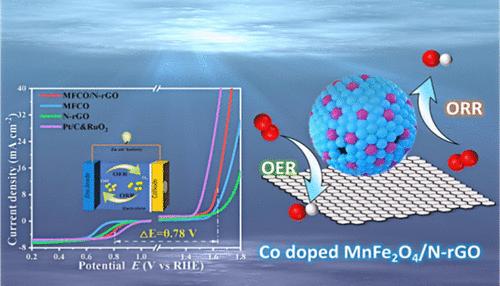钴掺杂MnFe2O4尖晶石与氮掺杂还原氧化石墨烯耦合:增强锌-空气电池的氧电催化活性
IF 3.9
2区 化学
Q2 CHEMISTRY, MULTIDISCIPLINARY
引用次数: 0
摘要
采用两步水热法制备了锚定在N-rGO上的MFCO尖晶石作为双功能电催化剂。对其理化性质进行了表征和测试,并将其应用于锌空气电池中。实验和理论计算表明,MFCO在N-rGO表面分布均匀。当MFCO锚定在导电的N-rGO上时,Co-N键之间发生协同作用,使C-N键的排列由sp2取向转变为sp3取向。MFCO/N-rGO电催化剂的ORR催化途径以4电子转移为主,其半波电位为0.8003 V,过电位值为352 mV,电位差较小(ΔE = 0.78 V),充放电电压差约为0.88 V,在650 h后的长时间内电压间隙几乎保持不变,表现出优异的稳定性。催化性能的提高是由于Co作为活性位点,Co的掺杂引起了Jahn-Teller效应,改变了尖晶石的电子结构,使d带中心上移,增强了对氧中间体的吸附,促进了氧电催化反应。本研究为锌-空气电池提供了一种低成本、有发展前景的双功能氧电催化剂。本文章由计算机程序翻译,如有差异,请以英文原文为准。

Cobalt-Doped MnFe2O4 Spinel Coupled with Nitrogen-Doped Reduced Graphene Oxide: Enhanced Oxygen Electrocatalytic Activity for Zinc-Air Batteries
MFCO spinel anchored on N-rGO is synthesized by a two-step hydrothermal method as a bifunctional electrocatalyst. Its physicochemical properties have been characterized and tested, and it is applied to zinc-air batteries. The experimental and theoretical calculations show that the MFCO is uniformly distributed on the surface of N-rGO. When MFCO is anchored on the conducting N-rGO, a synergistic effect occurs between the Co–N bonds, which changes the arrangement of the C–N bonds from the sp2 orientation to the sp3 form. The ORR catalytic pathway of the MFCO/N-rGO electrocatalyst is dominated by 4-electron transfer, with a half-wave potential of 0.8003 V, an overpotential value of 352 mV, and a small potential difference (ΔE = 0.78 V). With a charge/discharge voltage difference of about 0.88 V, the voltage gap remains almost unchanged for a long period after 650 h, showing excellent stability. The improved catalytic performance is attributed to Co acting as an active site, and the doping of Co induces the Jahn–Teller effect, which alters the electronic structure of spinel, shifts the d-band center upward, enhances the adsorption of oxygen intermediates, and promotes the oxygen electrocatalytic reaction. This study provides a low-cost and promising bifunctional oxygen electrocatalyst for zinc-air batteries.
求助全文
通过发布文献求助,成功后即可免费获取论文全文。
去求助
来源期刊

Langmuir
化学-材料科学:综合
CiteScore
6.50
自引率
10.30%
发文量
1464
审稿时长
2.1 months
期刊介绍:
Langmuir is an interdisciplinary journal publishing articles in the following subject categories:
Colloids: surfactants and self-assembly, dispersions, emulsions, foams
Interfaces: adsorption, reactions, films, forces
Biological Interfaces: biocolloids, biomolecular and biomimetic materials
Materials: nano- and mesostructured materials, polymers, gels, liquid crystals
Electrochemistry: interfacial charge transfer, charge transport, electrocatalysis, electrokinetic phenomena, bioelectrochemistry
Devices and Applications: sensors, fluidics, patterning, catalysis, photonic crystals
However, when high-impact, original work is submitted that does not fit within the above categories, decisions to accept or decline such papers will be based on one criteria: What Would Irving Do?
Langmuir ranks #2 in citations out of 136 journals in the category of Physical Chemistry with 113,157 total citations. The journal received an Impact Factor of 4.384*.
This journal is also indexed in the categories of Materials Science (ranked #1) and Multidisciplinary Chemistry (ranked #5).
 求助内容:
求助内容: 应助结果提醒方式:
应助结果提醒方式:


